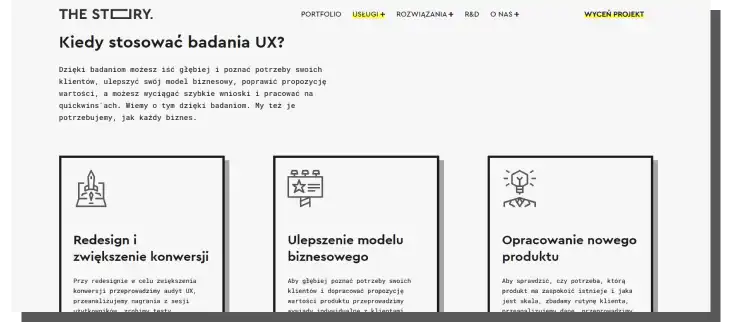There's a Polish movie, "What Will You Do When You Catch Me?" in which a certain customer says, "I will travel to Bydgoszcz, but I won't buy here!"
In short, it means that the customer will go shopping anywhere else but the store in which they are. When shopping online, everybody acts like the customer from that movie. And that's fine!
We live in a world of "I want it all." We have a choice; thus, we can have expectations. What do customers expect from online stores? What drives sales in E-Commerce and M-Commerce? How does UX relate to E-Commerce?
Today we'll discuss these issues.
Expectations of E-Commerce customers
What are the characteristics of customers? They have needs, habits, preferences, attitudes, experiences, and motivations. They also have expectations.
And, above else, they're always right. There are a lot of differences between online and stationary store customers. But they also have many similarities.

What are their differences?
Among the most crucial differentiating variables are the following:
- Socio-demographic variables (e.g., age, gender, wealth)
- Way of making a purchasing decision (especially regarding the speed and place)
- Attitude toward purchasing the product (e.g., expressed in having various amounts of information and experiences needed to make a purchase)
- The goal of shopping (e.g., fulfilling a need)
- Method of shopping (e.g., level of engagement, independence in decision-making)
- Preferred way of shopping (e.g., shopping in an online or stationary store)
- Method of evaluation of a product, service, or offer
- Way of obtaining information and opinions about a product or a store
- Manner of responding to product availability
- Frequency, regularity, and cyclicity of purchases.
Naturally, there will be fewer common characteristics. Ultimately, people have more differences than similarities (particularly when we dive into details). However, beware! This doesn't mean that there will be fewer expectations! Store customers expect quite a lot. We'll talk about it in detail in a moment.

Common characteristics exist, and they're vital. They allow you to optimize the offer, design, way of working, and strategy of an online store. They also enable you to optimize (after a UX audit) user/customer experience.
So, what do online store customers have in common? What are their expectations?
The most typical expectations include the following:
- Various forms of communication with consultants
- Flexible payment methods in an online store
- Information on the cost of the delivery, or even better, free delivery
- Uniform and trouble-free shopping experience
- Specific and exhaustive product description
- Ability to buy in an online store without registering
- Offering quick, free, and easy returns and exchanges
- Precise search engines consistent with the perceptions of customers
- Quick delivery
- Credibility and trust — access to ratings and reviews on a product page
- High-quality photos.
The hierarchy of expectations of E-Commerce customers will be slightly different depending on the country, market, customer segment, type of product, the needs it fulfills, and the store's market position.
We've written about types of E-Commerce customers in a separate article. Today, we'll only add that individual types of customers from the above list give different ranks of importance to the expectations. They also expect various functionalities from the online store.
You should also remember that meeting all these expectations is a product of several factors. The most important include the following:
- Technology (e.g., related to the performance of the E-Commerce platform on which the store was created)
- Organization and service
- Offer and assortment
- Functions and usability
- Flexibility and image.
From the customer's perspective, a word that combines all these issues is experience. It's what will motivate people to buy, and it's important to remember that conversion in online stores averages between 1.5 and 2%.
Transforming the above areas of the store into a consistent and compelling experience is the most often recommended method.
And there's nothing surprising about that; the user experience is currently one of the most crucial methods for increasing competitiveness in E-Commerce and M-Commerce. UX Audit, optimization regarding user experience, and customer research are the most often recommended actions.

Testing solutions, user experience research, usability testing, discovering more detailed, specific expectations, and facing entirely new expectations (we'll talk about them in a moment) allows you to improve Key Performance Indicators (KPIs) in E-Commerce and M-Commerce.
Expectations of online store customers in E-Commerce — recommendations of Nielsen Norman Group
In an age dominated by global brands — Amazon, Alibaba — understanding customer expectations and meeting them for smaller players is an opportunity and, even more, a necessity. Fulfilling expectations allows you to compete more effectively.
However, it should be noted right away that what matters isn't only that you fulfill them but also how you fulfill them.
Ultimately, E-Commerce solutions can be implemented well or poorly, in line with customer preferences or only partially in line with their expectations.

Easier written than done? Not necessarily. Particularly when you can use the knowledge, research, and experience of researchers from Nielsen Norman Group in the article "The New Ecommerce User Experience: Changes in Users' Expectations," you can find a fascinating synthetic approach to the problem of expectations and user/customer experience.
Let's get into the details. Based on proprietary research (the report was published in 2018), researchers from NN Group observed a significant change in expectations of the E-Commerce customer. They entail six dimensions:
- Experience
- Options
- Accuracy
- Speed
- Convenience
- Assurance.
Experience should be understood as a consistent combination of what the E-Commerce customer experiences in stationary and online stores. It's a big mistake to treat them as separate channels, loosely or entirely unrelated.
The online and offline worlds should overlap and complement each other. They should guarantee consistent, common, and satisfactory experiences.
Options — that are unrestricted and complete — are a standard that customers expect. This relates to assortment, payment methods, returns, complaints, delivery, and configuration of cyclical orders and channels. In short, the customer can sing to store owners, "I want it all, and I want it now." And they will be right.
Accuracy is also desirable; it's related to every aspect: delivery time, description of dimensions, way of working, prices, customer and expert opinions, and terms of returns. The description should be specific, easily accessible, and unambiguous. It has to dispel doubts, not be their source.
Speed of delivery, order fulfillment — a holy Grail of E-Commerce "By today, by tomorrow, ultimately within three days, not a minute longer!" Speed and certainty (a guarantee that's not only declarative) of product delivery is a requirement that needs to be met. It's simply a standard.

Convenience is the ability to combine offline and online experiences. It's an opportunity for multidirectional familiarization and buying. Online stores should encourage shopping in stationary stores, and stationary stores should suggest buying online.
Today, Convenience doesn't mean the competitiveness of these two worlds but their overlapping.
Assurance while shopping is a certainty of transaction security, respecting customers' data and using it according to the terms and conditions and for purposes of which customers are aware and consent to. They want to buy safely and confidently with a sense that their rights and expectations are respected.
The NN Group researchers' proposal has the advantage of universality. Values described above are essential for every store regardless of which E-Commerce industry it operates in and in which market.
Are these all the expectations that companies selling products online might face today? Not necessarily. In the coming years, new ones will intensify.
New expectations of E-Commerce customers
The phenomena of Showrooming and Webrooming, the ability to familiarize with a product in a stationary store to buy it online, and vice versa, will become increasingly important. A smooth flow between these types of behavior will become an essential element of customer experience optimization.

Moreover, customers expect fast and seamless contact with customer support in the store. They don't want to be the fourth user in line. Many communication channels (chat, e-mail, hotline) and the ability to quickly reach them from different places (stores, social media) are supposed to fulfill this expectation.
Continuous expansion of forms of contact and using new messengers (besides Messenger or Telegram) should be included in optimization plans.
Furthermore, customers expect not only easy contact with customer support through social media, but they also want to buy through them. Hence, social media such as Facebook or Instagram are becoming a natural extension of online stores and their social media branches.
Convenient shopping increasingly often means buying with voice.
Optimizing online stores and interfaces in E-Commerce regarding Voice Search is no longer a novelty, a curiosity.
It's not a technology "that needs to be tested." It's a technology being developed by Amazon (Amazon Echo) and Google (Google Home).
Expectations of online store customers in M-Commerce
What about customers shopping with mobile devices? Do their expectations differ significantly?
First of all, M-Commerce is becoming increasingly significant, and the share of this channel will gain strength. This process is driven by technological and civilizational changes and also the global pandemic.
The second question should also be answered affirmatively. Yes, the experiences of customers in the mobile channel significantly differ. It's not surprising. Mobile customers above else expect the following:
- Ability to perform tasks in any context quickly and simply
- Completing the purchase seamlessly (users more often buy on mobile phones rather than browse the offer, their interactions are far more often task-oriented)
- Adapting interfaces and product pages to various screen diagonals and resolutions, various platforms
- Reducing the number of forms and data necessary to enter during the purchase
- Ability to zoom in on photos
- Making a payment with one click
- Offering a virtual wallet that allows customers to pay without the need for verification of every transaction
- Providing special security measures for payments and flexible payments methods
- Using native functions of the mobile phone (e.g., geolocation).
M-Commerce customers expect more and more interaction points and integration of offline and online experiences.
They expect a creative and functional use of the potential of native functions of mobile phones and mobile applications.
And their connection with the local context, local markets, and social media.
Personalization in E-Commerce or how to improve user and customer experience
Personalization of E-Commerce and M-Commerce involves the continuous aggregation of data determining users' behavior, the devices they use, and their preferences summarizing historical purchases. Also, data from external sources (e.g., social media). These actions aim to adapt the offer to the customer's profile — their preferences.
Tailoring an offer and its adequacy is an increasingly common expectation that online stores try to fulfill with personalization.
The goal is to offer what the customer wants when they're looking for it and through the channel that is most convenient for them.
Mobile devices, due to their native functions, enable you to fulfill the "here and now" expectation. The change of context is not an obstacle but an opportunity. It's a possibility to offer personalized notifications, for example, during the browsing of offers from local stores.
E-Commerce UX. Summary
- Customers have needs, habits, preferences, attitudes, experiences, motivations, and specific expectations.
- Although customers differ significantly, their expectations are what they have in common.
- Common characteristics of different segments and types of customers allow you to optimize user/customer experience in online stores.
- There are at least a dozen widely shared expectations.
- The hierarchy of expectations differs depending on the country, market, customer segment, type of product, the needs it fulfills, and the store's market position.
- User experience is currently one of the most crucial methods for increasing competitiveness in E-Commerce and M-Commerce.
- Researchers from NN Group created a six-dimensional model of expectations of online store customers.
- A smooth flow between offline and online experiences is becoming an important part of optimizing the customer experience.
- Customers expect fast and seamless contact with customer support in the store.
- Social media are becoming a natural branch of an online store.
- Convenient shopping increasingly often means buying with voice.
- Experiences of customers in the mobile channel significantly differ.
- Mobile customers expect the ability to perform tasks in any context quickly, safely, and simply.
- Expectations of M-Commerce customers also include creative and functional use of the potential of mobile phones.
- Tailoring an offer and its adequacy is an increasingly common expectation that online stores try to fulfill with personalization.
- Mobile devices, due to their native functions, provide the opportunity to offer personalized notifications during the browsing of offers from local stores.






